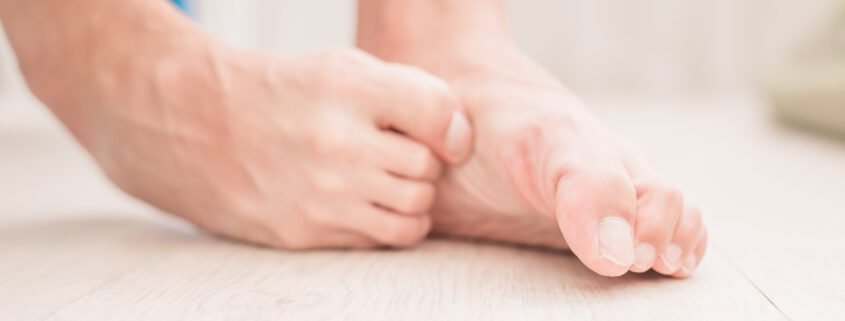What Does Athlete’s Foot Look Like?
Athlete’s foot, also known as tinea pedis, is a common fungal infection affecting the feet. It is caused by various fungi that thrive in warm, moist environments and can spread quickly through contact with contaminated surfaces or an infected person. Communal areas like gym locker rooms or public pools are often hotspots for transmission.
Despite its name, athlete’s foot is not exclusive to athletes. It can affect anyone, but some people are at increased risk, such as those who sweat heavily, wear tight-fitting shoes, or walk barefoot in public places.
If you suspect you may have athlete’s foot, contact Missouri Foot & Ankle for a prompt diagnosis and effective treatment.
The Progression and Symptoms of Athlete’s Foot
Athlete’s foot is a fungal infection that causes a rash on the feet. The rash can vary in severity and differ from person to person, depending on the fungus causing the infection.
The early stages of athlete’s foot are often characterized by white, macerated skin between the toes, with a noticeable odor. If left untreated, the infection can progress to scaling, peeling, and cracking of the skin on the bottom and sides of the foot. In severe cases, athlete’s foot can cause thick, dry, scaly skin resembling a moccasin shape on the bottom of the foot or numerous small, red, itchy blisters on the sole of the foot.
Other symptoms of athlete’s foot may include:
- Redness and inflammation
- Tenderness
- Burning or stinging sensation
If you have any of these symptoms, schedule an appointment with Missouri Foot & Ankle for a proper diagnosis and treatment. Early treatment is critical in preventing complications and getting rid of the infection quickly and effectively.
How Does Athlete’s Foot Spread?
Athlete’s foot spreads through contact with contaminated surfaces, such as public showers, locker rooms, and swimming pools. It can also live in shoes for long periods, making footwear a common culprit in re-infections.
How Long Can Athlete’s Foot Live In Shoes?
The fungi that cause athlete’s foot, known as dermatophytes, thrive in dark, moist environments such as the insides of shoes, particularly when damp from sweat. Studies have shown that fungi can survive in shoes for a few months, giving them more potential to spread.
How Long Can Athlete’s Foot Last?
Athlete’s foot can last for a long time without treatment and may even get worse over time. This can lead to more discomfort and potential complications. The infection may go away for a while, but it can return if the conditions allow the fungus to grow. With proper treatment and hygiene, most cases of athlete’s foot can clear up within two to four weeks.
Athlete’s Foot Prevention Tips
To help prevent athlete’s foot, follow these tips:
- Wash your feet daily with soap and water. Pay special attention to the spaces between your toes. Dry your feet thoroughly after washing.
- Wear breathable shoes and socks. Avoid wearing shoes that are too tight or made from materials that do not breathe, such as vinyl or rubber. Change your socks frequently, especially if your feet sweat a lot.
- Avoid walking barefoot in public places. Wear flip-flops or shower shoes in locker rooms, public pools, and other communal areas.
- Keep your shoes clean and dry. If your shoes get wet, let them dry out completely before wearing them again. You can also spray your shoes with an antifungal spray to help prevent fungus growth.
How Missouri Foot & Ankle Can Treat Your Athlete’s Foot
Knowing what athlete’s foot looks like and spotting the signs early aids in a faster recovery and lowers the risk of spreading the infection to others. Always watch out for persistent itching, redness, peeling, or blistering on your feet, especially between your toes. If you suspect you might have athlete’s foot, Missouri Foot & Ankle is ready to help.
At Missouri Foot & Ankle, we are committed to providing you with the utmost care and effective treatment options. Together, we can help you get back on your feet and live your life free from the discomfort of athlete’s foot.


